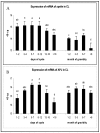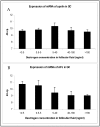The expression of apelin and its receptor APJ during different physiological stages in the bovine ovary
- PMID: 19461937
- PMCID: PMC2684680
- DOI: 10.7150/ijbs.5.344
The expression of apelin and its receptor APJ during different physiological stages in the bovine ovary
Abstract
Recent studies implicate that apelin and its receptor APJ may have important role for the modulation of angiogenesis. The aim of this study was to further characterise the regulation of apelin/APJ system in bovine ovary. Experiment 1: corpora lutea (CL) were assigned to the following stages: days 1-2, 3-4, 5-7, 8-12, 13-16, >18 (after regression) of oestrous cycle and of gravidity (month <3, 3-5, 6-7 and >8). Experiment 2: Follicles during maturation were divided into granulosa cells (GC) and theca interna (TI) and were examined separately. Classification of follicles occurred by follicle size and oestradiol-17beta (E2) concentration in the follicular fluid (FF) (<0.5 ng/ml, 0.5-5 ng/ml; 5-40 ng/ml; 40-180 ng/ml; >180 ng/ml). Real-time RT-PCR (qPCR) was applied to investigate mRNA expression of examined factors. In general, the expression level of apelin during the oestrous cycle was significantly higher compared to the one during pregnancy. Apelin mRNA levels were always high during the cycle with a tendency of decrease after CL regression. The APJ mRNA in the CL was significantly up regulated on days 5-7 and 8-12 followed by a decrease on days 13-16, and further on days >18. The expression of APJ does not show any significant regulation in the CL throughout pregnancy. The expression of apelin and APJ was not statistically regulated in GC, but was significantly up regulated in follicles with an E2 concentration of more than 5 ng/ml and showed an increase according to growth and maturation of follicles. In conclusion, our data suggest that apelin/APJ system is involved in the mechanism regulating angiogenesis during follicle maturation as well as during CL formation and function in the bovine ovary.
Keywords: angiogenesis; apelin; bovine ovary; corpus luteum; follicle.
Conflict of interest statement
CONFLICT OF INTEREST: The authors have declared that no conflict of interest exits.
Figures



Similar articles
-
Expression and localization of apelin and apelin receptor (APJ) in buffalo ovarian follicles and corpus luteum and the in-vitro effect of apelin on steroidogenesis and survival of granulosa cells.Theriogenology. 2023 Feb;197:240-251. doi: 10.1016/j.theriogenology.2022.12.013. Epub 2022 Dec 9. Theriogenology. 2023. PMID: 36525863
-
Apelin and APJ receptor expression in granulosa and theca cells during different stages of follicular development in the bovine ovary: Involvement of apoptosis and hormonal regulation.Anim Reprod Sci. 2009 Nov;116(1-2):28-37. doi: 10.1016/j.anireprosci.2009.01.009. Epub 2009 Jan 24. Anim Reprod Sci. 2009. PMID: 19223129
-
Expression and localization of apelin and its receptor APJ in the bovine corpus luteum during the estrous cycle and prostaglandin F2alpha-induced luteolysis.Reproduction. 2008 Apr;135(4):519-25. doi: 10.1530/REP-07-0409. Reproduction. 2008. PMID: 18367512
-
Possible role of growth hormone, IGFs, and IGF-binding proteins in the regulation of ovarian function in large farm animals.Domest Anim Endocrinol. 1999 Oct;17(2-3):279-85. doi: 10.1016/s0739-7240(99)00044-2. Domest Anim Endocrinol. 1999. PMID: 10527130 Review.
-
The beneficial roles of apelin-13/APJ system in cerebral ischemia: Pathogenesis and therapeutic strategies.Front Pharmacol. 2022 Aug 10;13:903151. doi: 10.3389/fphar.2022.903151. eCollection 2022. Front Pharmacol. 2022. PMID: 36034795 Free PMC article. Review.
Cited by
-
Plasma apelin levels in patients with polycystic ovary syndrome.J Turk Ger Gynecol Assoc. 2012 Mar 1;13(1):27-31. doi: 10.5152/jtgga.2011.74. eCollection 2012. J Turk Ger Gynecol Assoc. 2012. PMID: 24627671 Free PMC article.
-
Evaluation of Apelin and Insulin Resistance in Patients with PCOS and Therapeutic Effect of Drospirenone-Ethinylestradiol Plus Metformin.Med Sci Monit. 2015 Aug 28;21:2547-52. doi: 10.12659/MSM.894926. Med Sci Monit. 2015. PMID: 26314870 Free PMC article.
-
Identification of DNA Methylation Differences in Pituitary Tissues of Sichuan White Geese Using Whole-Genome Bisulfite Sequencing (WGBS).Biology (Basel). 2025 Feb 3;14(2):154. doi: 10.3390/biology14020154. Biology (Basel). 2025. PMID: 40001922 Free PMC article.
-
Progress of Adipokines in the Female Reproductive System: A Focus on Polycystic Ovary Syndrome.Front Endocrinol (Lausanne). 2022 May 26;13:881684. doi: 10.3389/fendo.2022.881684. eCollection 2022. Front Endocrinol (Lausanne). 2022. PMID: 35692386 Free PMC article. Review.
-
Investigation of apelin expression in endometriosis.J Reprod Infertil. 2013 Apr;14(2):50-5. J Reprod Infertil. 2013. PMID: 23926564 Free PMC article.
References
-
- Edinger AL, Hoffman TL, Sharron M, Lee B, Yi Y, Choe W, Kolson DL, Mitrovic B, Zhou Y, Faulds D, Collman RG, Hesselgesser J, Horuk R, Doms RW. An orphan seven-transmembrane domain receptor expressed widely in the brain functions as a coreceptor for human immunodeficiency virus type 1 and simian immunodeficiency virus. J. Virol. 1998;72(10):7934–7940. - PMC - PubMed
-
- Tatemoto K, Hosoya M, Habata Y, Fujii R, Kakegawa T, Zou MX, Kawamata Y, Fukusumi S, Hinuma S, Kitada C, Kurokawa T, Onda H, Fujino M. Isolation and characterization of a novel endogenous peptide ligand for the human APJ receptor. Biochem. Biophys. Res. Commun. 1998;251(2):471–476. - PubMed
-
- Kawamata Y, Habata Y, Fukusumi S, Hosoya M, Fujii R, Hinuma S, Nishizawa N, Kitada C, Onda H, Nishimura O, Fujino M. Molecular properties of apelin: tissue distribution and receptor binding. Biochim. Biophys. Acta. 2001;1538(2-3):162–171. - PubMed
-
- Habata Y, Fujii R, Hosoya M, Fukusumi S, Kawamata Y, Hinuma S, Kitada C, Nishizawa N, Murosaki S, Kurokawa T, Onda H, Tatemoto K, Fujino M. Apelin, the natural ligand of the orphan receptor APJ, is abundantly secreted in the colostrum. Biochim. Biophys. Acta. 1999;1452(1):25–35. - PubMed
-
- De Falco M, De Luca L, Onori N, Cavallotti I, Artigiano F, Esposito V, De Luca B, Laforgia V, Groeger AM, De Luca A. Apelin expression in normal human tissues. In Vivo. 2002;16(5):333–336. - PubMed
Publication types
MeSH terms
Substances
LinkOut - more resources
Full Text Sources
Molecular Biology Databases
Miscellaneous

